(TITC) - Tam Chuc Pagoda Complex is considered as the largest in the world, and is an attractive destination for many visitors and buddhist followers. You should spend one day trip to Tam Chuc to contemplate a spectacular landscape and learn more about Buddhism.

Overview of Tam Chuc Pagoda Complex. Photo: internet
Tam Chuc Pagoda Complex is located in Ba Sao Town, Kim Bang District, Ha Nam Province, 12 km from Phu Ly City, and about over 70 km south of Ha Noi. It lies in an area of about 5,000 hectares, has a unique location, because its back leaning on the mountain, and face overlooking the lake, which creats a poetic scenery like a fairyland.
The legend of Tam Chuc Pagoda
Tam Chuc Pagoda is associated with the legend of "Tien Luc Nhac - Hau That Tinh" meaning “Six music bells in front – Seven stars after”. Legend has it that, on the southwestern mountain range towards Huong (Perfume) Pagoda (in My Duc District, Ha Noi), there are 99 mountains, seven of which are nearest to Tam Chuc village, called That Tinh mountains (or Seven-star mountains); and the pagoda here was called That Tinh pagoda.
On these 7 mountains, there appeared a big spot of light like 7 halo shining stars. The persons who saw that aura came to the Seven-star Mountains to gouge, pile firewood and burn for many days in order to take away the 7 stars. Out of the 7 stars, 4 were burned so much that they faded, only 3 stars left. Therefore, the That Tinh Pagoda was later renamed Ba Sao (three stars) (later named Tam Chuc Pagoda). In front of the pagoda was Tam Chuc Lake with 6 small mountains inside, it was said that 6 bells of heaven were brought down (music in front).
Through many ups and downs of space and time, this place remains only buried stone columns, wooden columns and beams. According to the collected artifacts, archaeologists have supposed that the ancient Tam Chuc Pagoda was more than 1000 years old, and was built under the Dinh Dynasty (10th century).
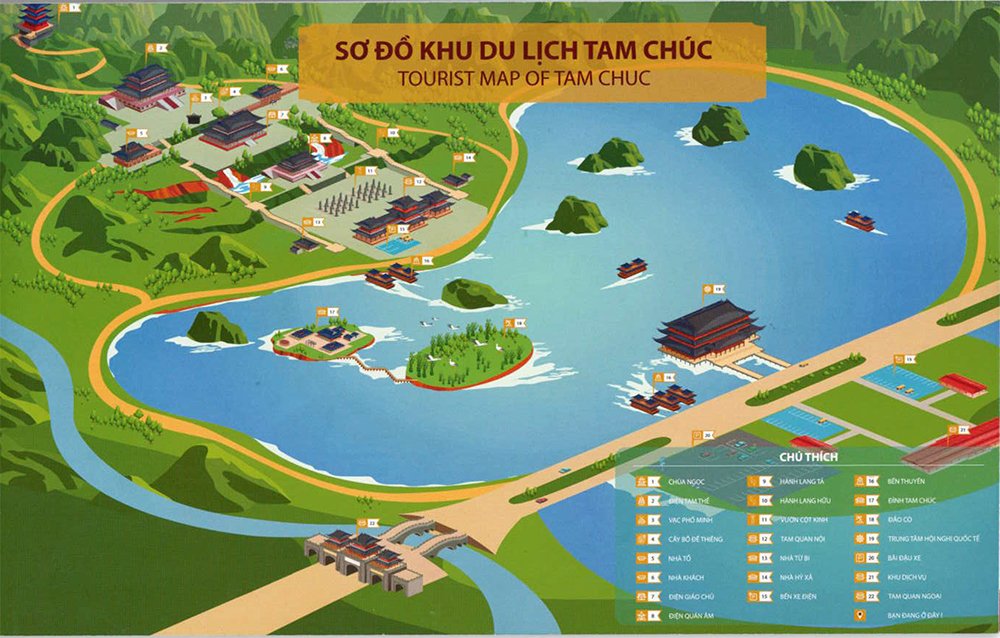
Map of Tam Chuc Pagoda
Architecture of Tam Chuc Pagoda
The current Tam Chuc Pagoda Complex built on the foundation of the ancient Tam Chuc Pagoda was inaugurated in May 2019. The pagoda overlooks Tam Chuc Lake (also known as Luc Nhac Lake), with constructions such as interior Tam Quan (Three-entrance) Gate, Sutra Pillar Garden, Quan Am (Kwan Yin) Temple, Phap Chu Temple, Tam The Temple and Ngoc (Ruby) Pagoda. In addition, in Tam Chuc pagoda complex, there are also the exterior Tam Quan (Three-entrance) Gate, International Conference Center, Thuy Dinh Guest House and Tam Chuc Communal House, and Tu An Temple. Overall shows a wonderful combination of impressive architectural works between the breathtaking natural landscapes.
Especially, Tam Chuc Pagoda Complex is constructed by many skilled Vietnamese and foreign artisans, many craftsmen of Buddhism, Hinduism, and Islam.
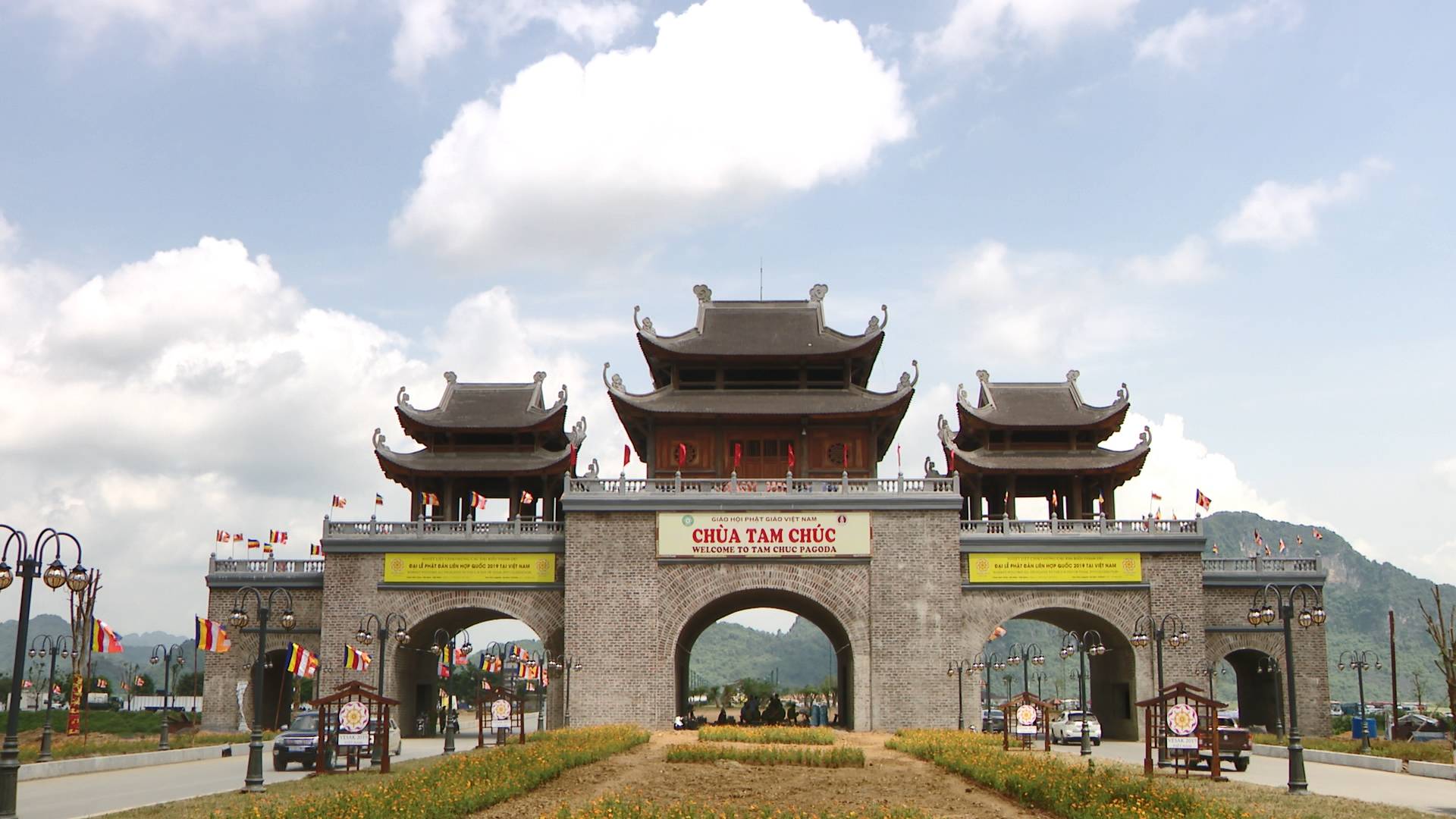
Exterior Tam Quan Gate. Photo: internet
Interior Tam Quan Gate is very big building with the height of 28.8m on the first floor area of 1,958m². It has 3 curved roof floors built in style of Vietnamese typical temple architecture. In front of the gate are the wharf and the tram parking. The two sides of the Tam Quan Gate have two large paths leading to the main massive temples.
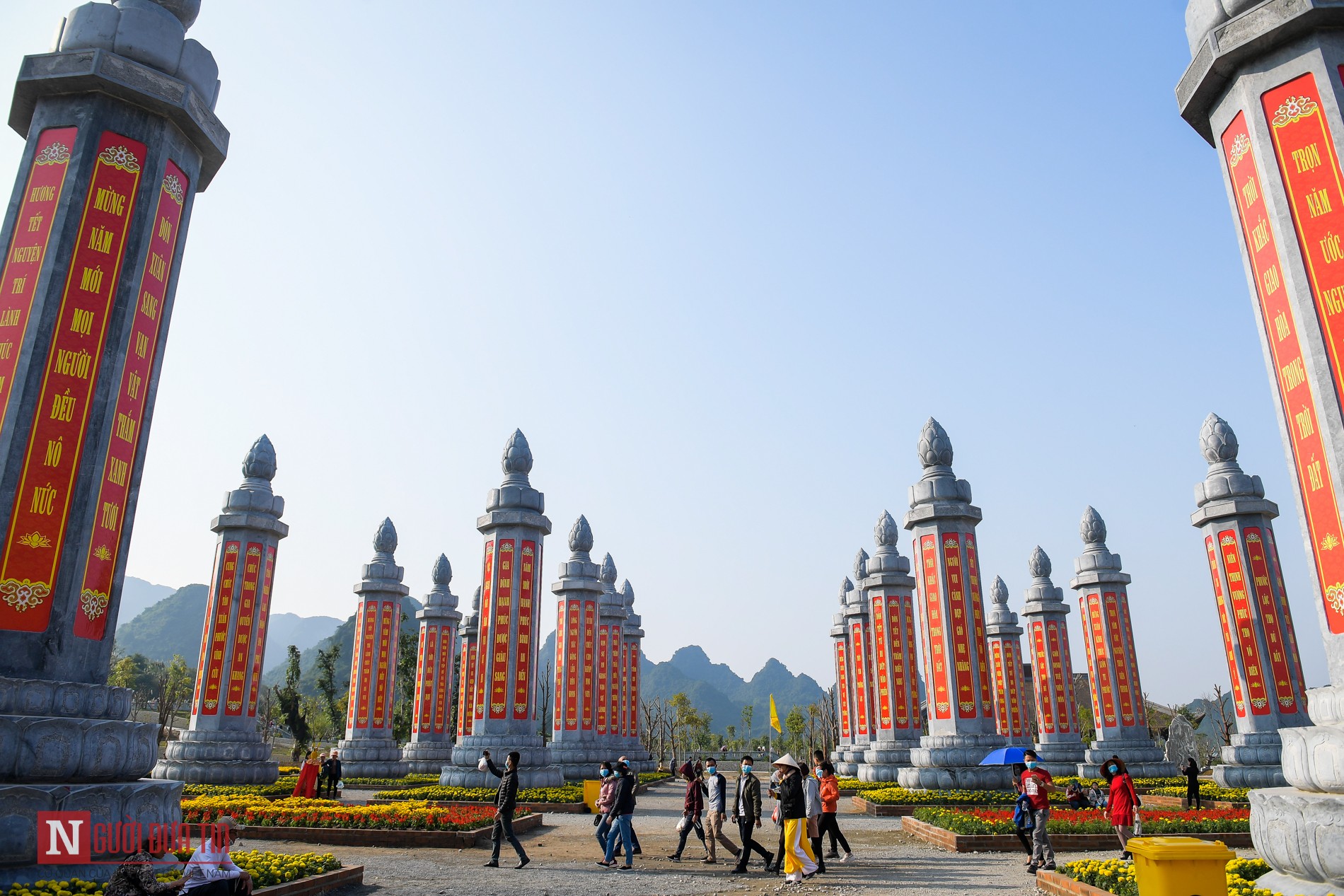
Sutra Pillar Garden. Photo: internet
From Tam Quan Gate to Quan Am Temple, visitors pass Sutra Pillar Garden with 32 big sutra pillars. Inspired by the national treasures of Nhat Tru Pagoda in Hoa Lu ancient capital, Ninh Binh Province, Sutra Pillar Garden is built on a large scale; each pillar is 13.5m high and weighs about 200 tons, made from monolithic blue stone of Thanh Hoa Province. The stone pillars are designed with a lotus pedestal; hexagonal body, hand-carved Buddha precepts; the top of the pillar is shaped like a lotus bud.
The 3 main temples of Tam Chuc Pagoda including Tam The Temple, Phap Chu Temple, and Quan Am Temple, are all magnificent, large, and have in common that there are stone relief paintings carved by Indonesian Muslim artisans from volcanic rock in Indonesia.
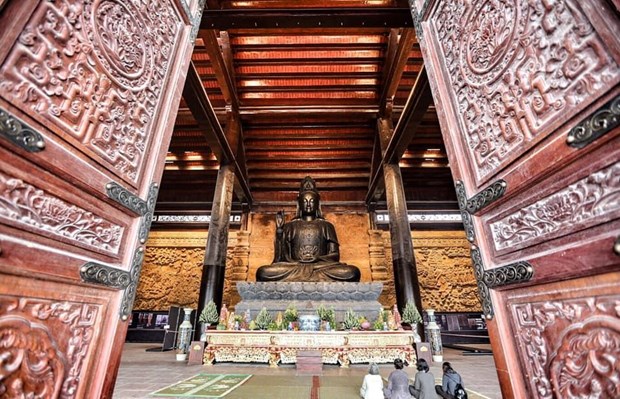
Quan Am Temple. Photo: internet
Quan Am Temple houses a monolithic bronze statue of Guan Yin Bodhisattva, weighing 100 tons casted by Vietnamese artisans and 8,500 stone relief paintings depicting stories of Buddha.
Via Quan Am Temple, visitors arrive to Phap Chu Temple including 2 floors, with curved roof, height of 31m, and floor surface of 3,000m².
The temple worships a monolithic bronze statue of Shakyamuni Buddha weighing 150 tons made by Vietnamese artisans. There are 10,000 relief paintings to depict the life of Buddha, from his birth, enlightenment, sermon and nirvana.
Tam The Temple is the largest building, is 39m high and 5,400m². Tam The Temple can accommodate up to 5,000 Buddhist followers performing the ceremony at the same time. There are 3 colossal Buddha statues representing the past, present and future; each made of black bronze weighs 80 tons and is decorated a large lotus leaf inlaid with gold behind. In addition, there are 12,000 intricately stone relief paintings, each of which contains an extremely human story describing the life of the Buddha.
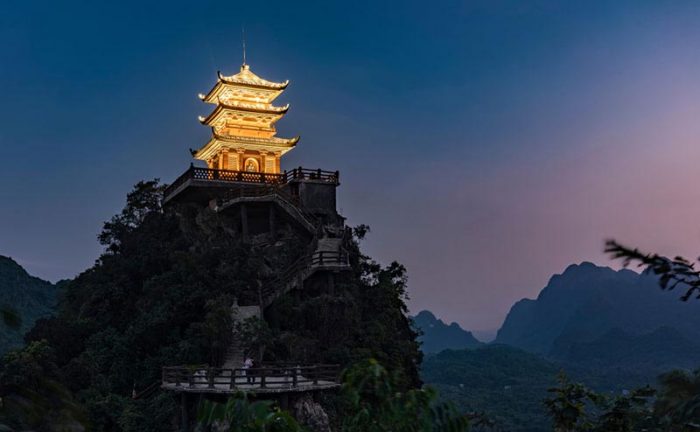
Ngoc (Ruby) Pagoda. Photo: internet
Ngoc (Ruby) Pagoda Going through the 3 main temples and walking quite a distance, visitors climb 299 steps to reach the Ngoc (Ruby) Pagoda located on top of That Tinh mountain at 468m above sea level. Ngoc Pagoda is 15m high, has 3 storeys with curved roof and area of 36m². The pagoda is built entirely of red granite slabs crafted by Indian Hindu artisans in India and transferred to install in Vietnamese ancient architectural style but without bonded concrete. So although the floor area is only 13m², but this pagoda weighs about 2,000 tons. The tower worships the statue of Buddha Amitabha weighing 4,000kg made of ruby stone imported from Myanmar.
Tam Chuc Pagoda Complex preserves three treasures: Bodhi Tree, Moon Meteorite and Bronze Cauldron.
Bodhi Tree located in the yard of Tam The Temple is extracted from the Great Bodhi Tree of over 2000 years old in Mahamegha Relic in Sri Lanka.
According to history, in 247 (BC), King Ashoka ordered extract a branch of the sacred Bodhi tree in Bodh Gaya in India (where the Buddha attained enlightenment). The island nation of Sri Lanka received the precious Bodhi tree branch from Princess Sanghamitta - sent by King Ashoka to present.
Also in the yard, placed a giant black bronze cauldron about 4m high, weighing more than 20 tons, casted after model of Pho Minh cauldron. In the body of the cauldron, well-known Vietnamese spiritual landscapes are sculpted.
Moon meteorite weighing 5.5kg was named "The Moon Puzzle", worth over USD 600,000 equivalent to VND 14 billion. The Moon meteorite fell from space into the Sahara desert from thousands of years ago, and was found in 2017. On October 19, 2018, at the RR Auction center, Boston (USA), Xuan Truong enterprise in Ninh Binh Province won the auction of this meteorite and displayed it at Tam Chuc Pagoda.
Coming to Tam Chuc Pagoda Complex, visitors do not miss to explore Luc Nhac Lake by boat and visit Tam Chuc communal house.
Luc Nhac Lake is one of the largest natural lakes in Viet Nam with surface area of 600 hectares. Three sides surrounded with mountain ranges, inside the lake there are six small mountains emerging from the water surface; it is that makes the majestic natural landscape. In the lake there are many species of animals and plants living.

Luc Nhac Lake. Photo: internet
Tam Chuc communal house located on the surface of Luc Nhac Lake worships Queen Duong Thi Nguyet of Dinh Dynasty (10th century) and preserves ancient traces from the Dinh Dynasty. Tam Chuc communal house connects with Co Island lying also in the lake by a zigzag bridge.
Every year, on the 12th day of the 1st lunar month, the Tam Chuc Pagoda Festival is held to pray for the peaceful nation and people. The festival is held with the ceremony of reciting Buddha's blessing, rituals of ringing bell and beating drum, offering incense, water procession at Tam Chuc Lake, water procession to the Ngoc Pagoda and organization of vegetarian party.
|
Tam Chuc Pagoda Complex was the place to successfully hold the United Nations Day of Vesak Celebration 2019 which took place from May 12-14, 2019 with the participation of 1,500 dignitaries and leaders of Buddhist sects, researchers coming from more than 100 countries and territories around the world and about 10,000 Buddhists and Vietnamese people. Tam Chuc Pagoda Complex has a convenient location to connect famous tourist sites and destinations such as Huong (Perfume) Pagoda (Ha Noi), Trang An, Bai Dinh Pagoda, Tam Coc Bich Dong, Cuc Phuong National Park (Ninh Binh Province), Tien Pagoda (Hoa Binh Province). Tam Chuc Pagoda Complex lies in Tam Chuc Tourist Site approved by the Prime Minister to develop as a national tourist site. Currently, Tam Chuc Tourist Area is still being built to develop 6 functional areas including reception center, Tam Chuc spiritual cultural area, Quen Vong nature reserve and Tam Chuc Lake, Tam Chuc community and wellness tourism area, Kim Bang golf course and Ba Hang Lake, and logistics center serving tourism activities. All constructions are expected to be completed in 2048. |
TITC
















